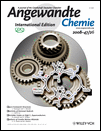On-Chip Micro Gas Chromatograph Enabled by a Noncovalently Functionalized Single-Walled Carbon Nanotube Sensor Array†
This work was supported by the Department of Homeland Security and the Federal Aviation Administration under grant DHS S&T 06-G-026. R. Masel acknowledges funding from Defense Advanced Research Projects Agency (DARPA) under U.S. Air Force grant FA8650-04-1-7121. SEM was carried out in the Center for Microanalysis of Materials, University of Illinois, which is partially supported by the U.S. Department of Energy under grantDEFG02-91-ER45439.
Graphical Abstract
Sensing in reverse: Reversible detection of as few as 109 molecules (1700 aM) of dimethyl methylphosphonate, a nerve agent simulant, is demonstrated at the end of a micro GC column (see picture). Such arrays form the basis of rapidly transducing molecular sensors with micrometer-sized footprints. The separation capability of the column eliminates the need for selectivity on the sensor, as long as analyte binding is reversible and rapid.





